An overview of collections, glossary, and resources pages
Navigating collections, glossary, and resources pages
The collections, glossary terms, and resources pages have a page level navigation available on the top to navigate long pages with ease. Dedicated tabs are also available to navigate related and contained resources quickly and efficiently in an info-dense tabular view.
To navigate the collection, glossary, resources pages:
Browse to any resource, glossary term, or collection you have access to.
On the Overview tab, you have access to a top navigation panel for easy browsing through the various page sections, especially useful when dealing with pages that have numerous content-heavy sections. The Overview tab displays a Relationships preview and the Eureka Explorer Lineage for resources.
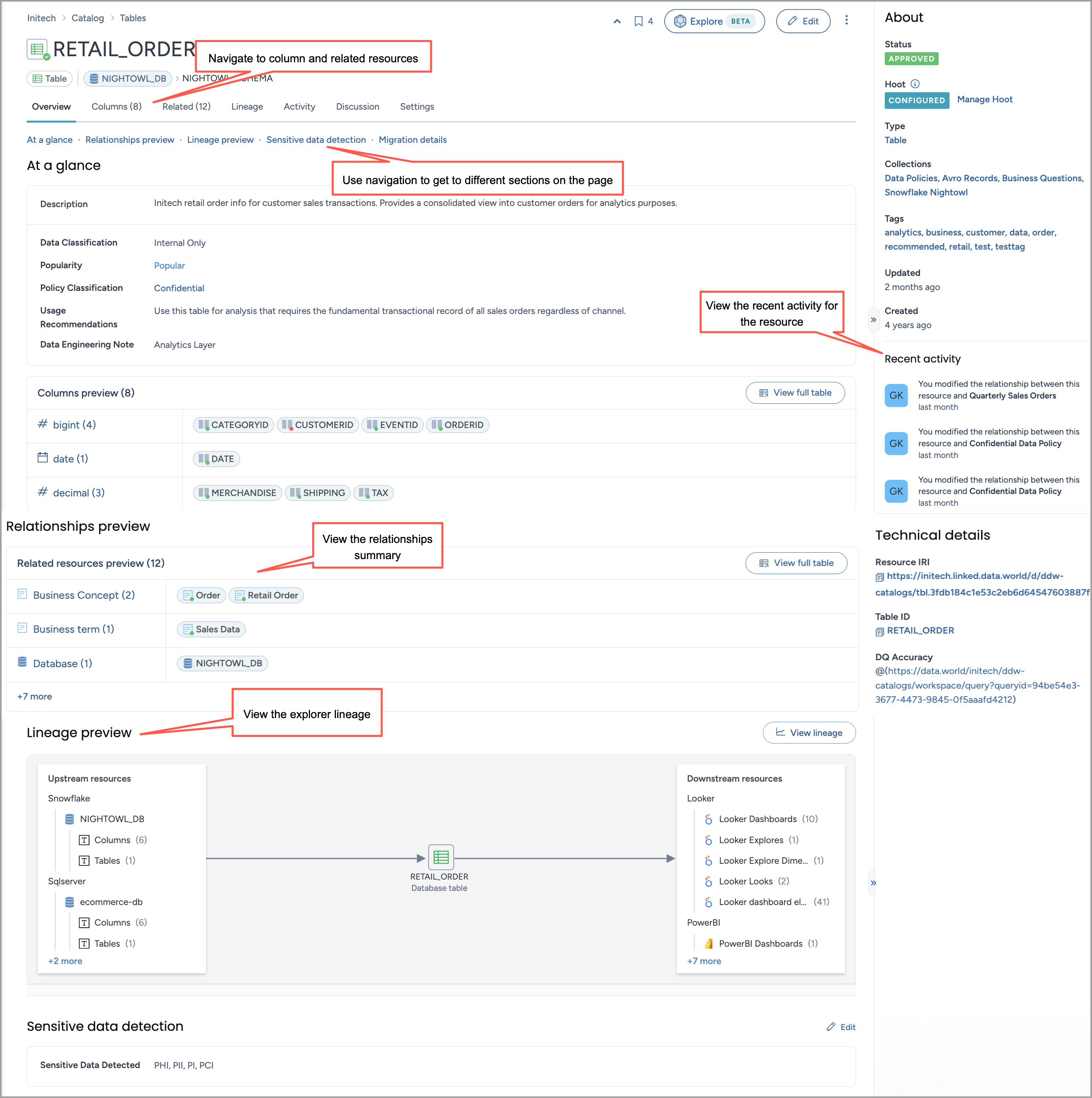
If you have setup relationships as fields (setup can be done using MDP or CTK), you will see those displayed on the Overview tab.
Next, you will notice dedicated tabs that display the Related resources and Contained resources. For resources like Tables, you will see a Columns tab which display the columns in the table.
Tables will always have Columns and Related tabs.
Analysis will always have the Related tab.
Business terms will always have Related tab.
Collections will always have Contains tab and may have Related tab.
Generic resources may have Related tab.
The Related tab only shows up when relationships are defined for the resource. For Tables, Analysis, Business Terms, and Columns relationships are defined by default and hence the Related tab is always visible on them. For every other resource type (including Collections), users have to define the relationships and the tab is only displayed when these relationships are defined.
From here you can navigate to the different related resources, remove the resources, or Add new resources.
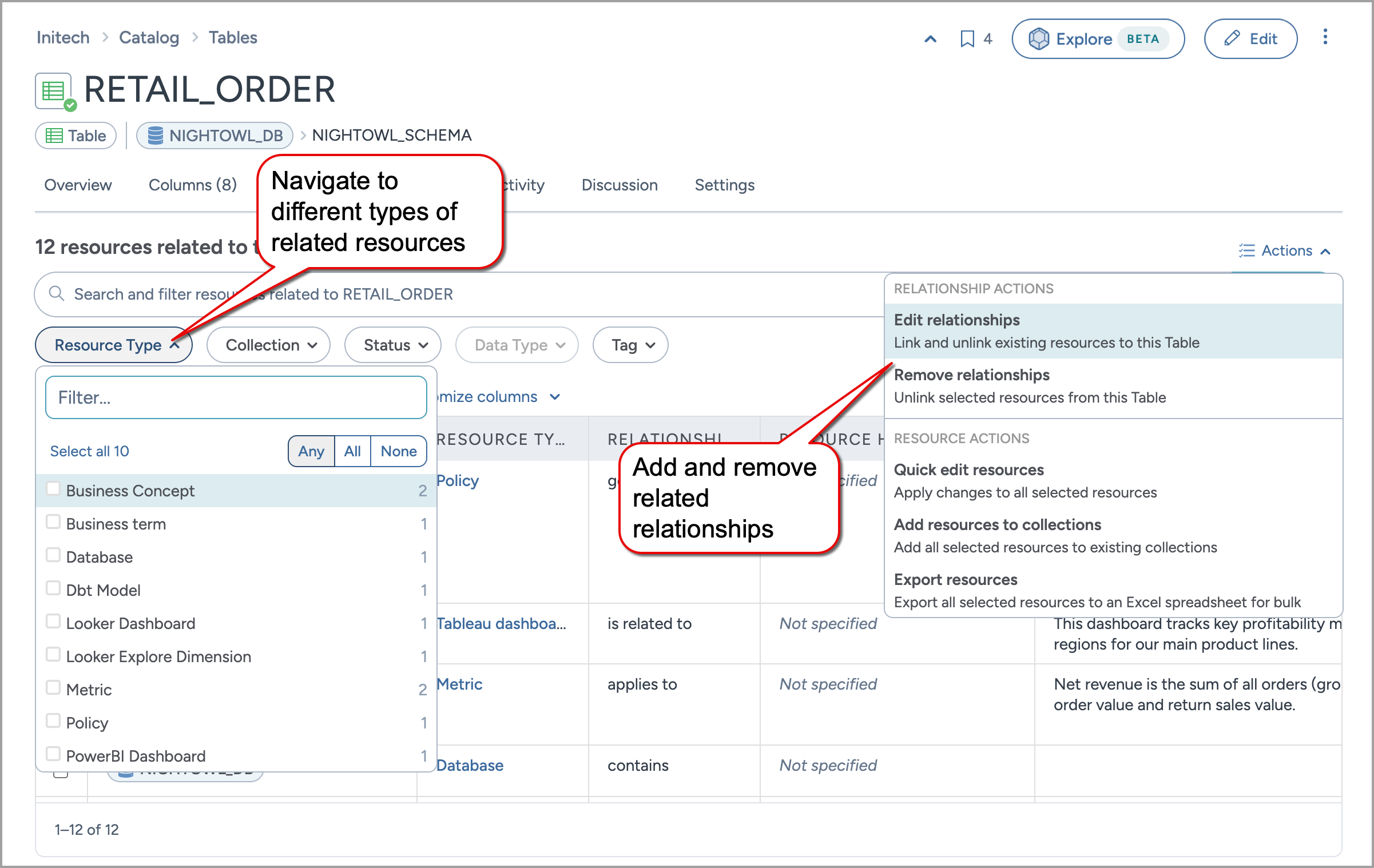
The Contains tab shows for Collections and displays all the resources contained in the collection. Navigate to the different sections in the tab to view the different resources contained in the collection. Use the Expand feature to view the resources in full screen mode.
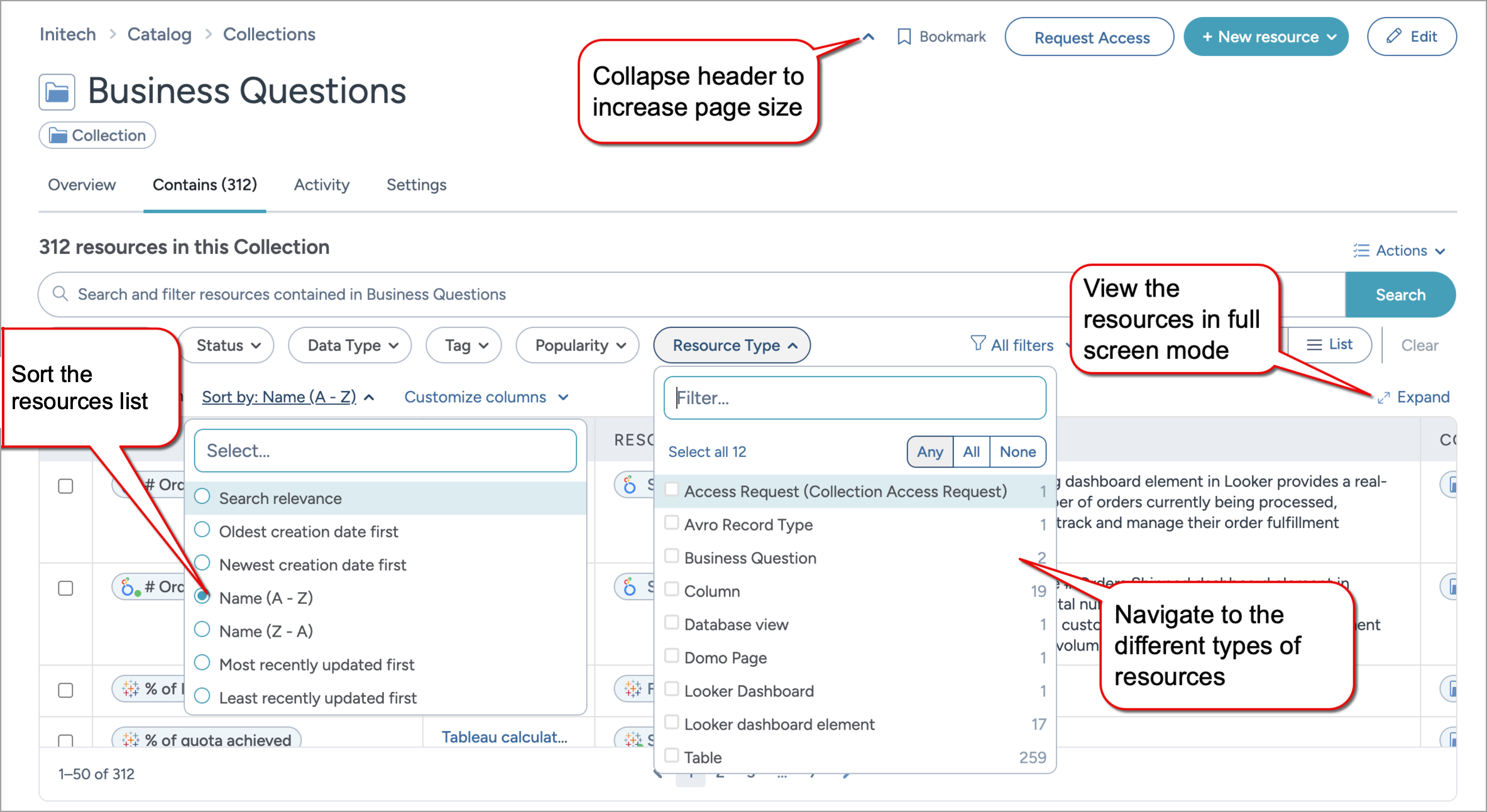
If you have the appropriate permissions, you also get an option to do quick edit of the resources.
For Tables, you get a Columns tab that lets you view all the columns in the table.

On all these tabs, all the fields show hover text that include complete details about the field when the text cannot be displayed in the column view. For fields like Created and Updated hover over the field values to see the actual date and time information.
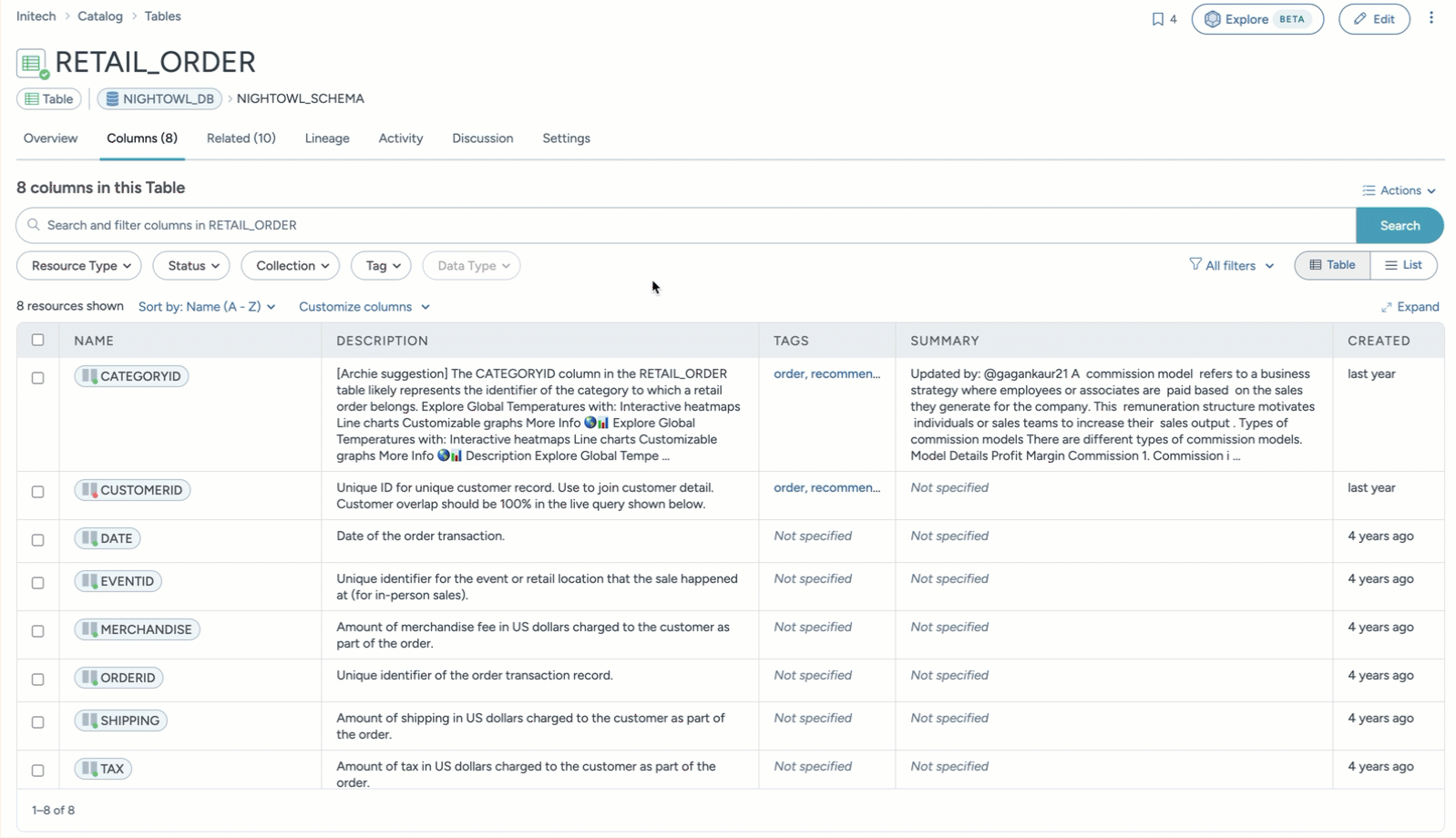
Sections and fields available on standard resource pages
The platform provides a set of predefined fields and sections for various types of resources such as Datasets, Projects, Analyses, Business terms, Collections, Tables, Columns, and Custom resources. These fields help structure and present resource information consistently across the platform, making it easier to navigate and manage your data.
If you need to extend these fields with custom metadata, please refer to our guides on Adding custom fields (MDP) and Creating custom fields (CTK) .
This topic provides a breakdown of the main resource sections and their associated fields.
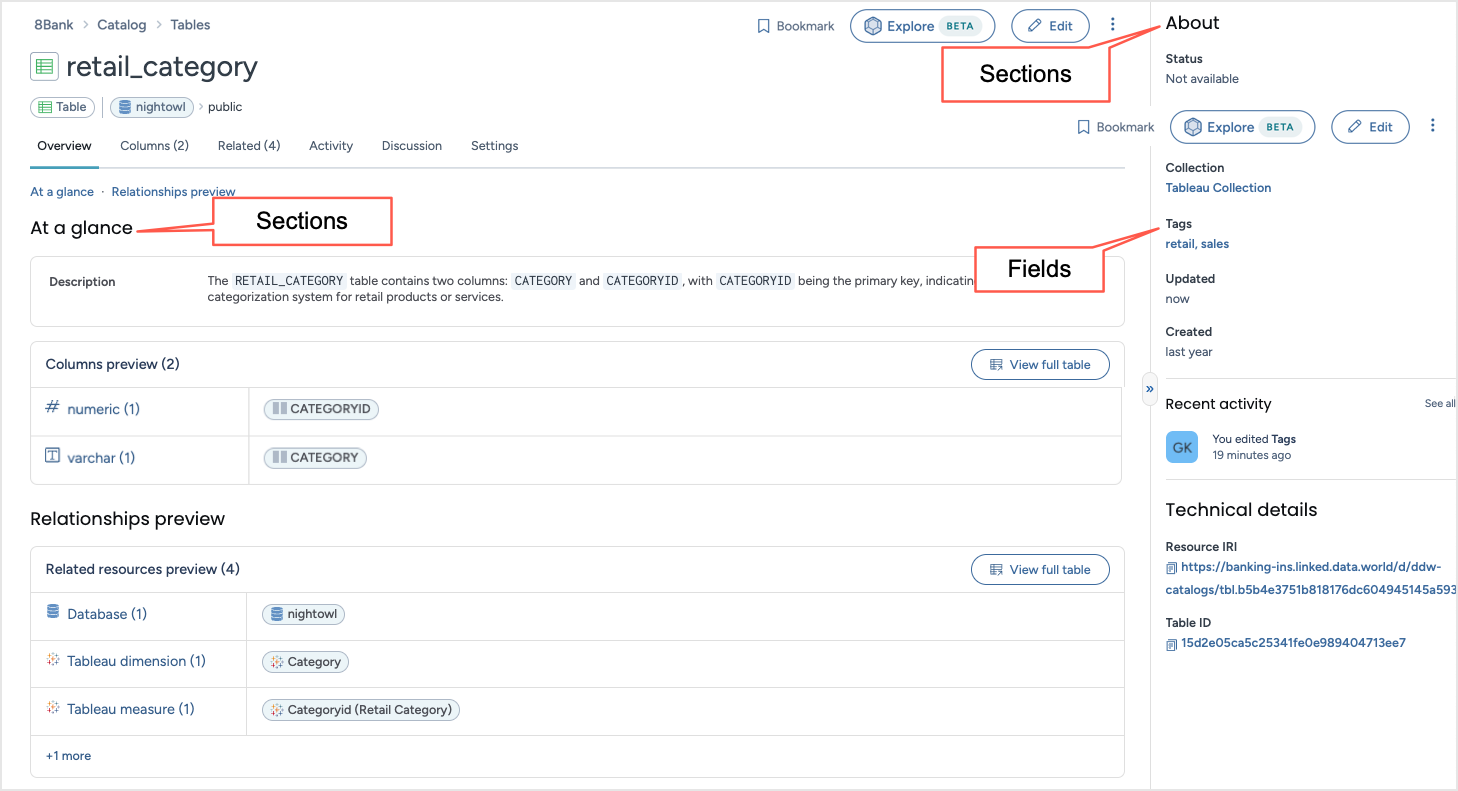
At a glance section
The At a glance section provides you an overview of the key information for a resource, such as its title, description, and a preview of columns associated with a table and resources contained in a collection.
Field name | Description | Displayed for resource types | Visible? |
|---|---|---|---|
Title | The title of the resource. | All resource types | Always |
Description | A brief description of the resource. | All resource types | Always |
Summary | A summary of the resource. | All resource types | Only if populated |
Columns preview | Details of column fields. | Tables | Always |
Contains preview | Lists the resources contained in the collection. | Collections | Always |
About section
The About section provides an overview of the key characteristics of the resource, such as its status, type of resource, and other core attributes.
Field name | Description | Displayed for resource types | Visible? |
|---|---|---|---|
Status | Status, such as, Approved, Rejected, Pending, etc. | All resource types | Always |
Type | The type of the resource. | All resource types | Always |
Collections | The collection resource belongs to. | All resource types except Datasets, Projects | Always |
Tags | Keywords associated with the resource. | All resource types | Always |
Created | Indicates the original creation timestamp of the resource. For resources created via a collector, this timestamp is also reset to the time of each TTL file synchronization. For resources created through the UI or API, it reflects the time of initial creation and matches the Updated timestamp at that point. | All resource types | Always |
Updated | Indicates the last modification timestamp of the resource. For resources created via a collector, this timestamp is reset to the time of each TTL file synchronization. For resources updated through the UI or API, it reflects the time of the most recent update. | All resource types | Always |
Source system | Indicates the origin of the data asset. | All resource types except Datasets, Projects, Tables, Columns | Only if populated |
Base type | The type of columns. For example, varchar. | Columns | Shown if present |
Database | The type of database. | Tables | Shown if present |
Relationships preview section
The Relationships preview section outlines the links and associations between different resources, helping you understand how they relate to each other within your data catalog.
Field name | Description | Displayed for resource types | Visible? |
|---|---|---|---|
Related | Links to associated resources | All resource types except Projects | Shown if relationships exist |
Collection hierarchy
Th Collection hierarchy section displays the tree-like structure of nested collections.
Field name | Description | Displayed for resource types | Visible? |
|---|---|---|---|
Collection hierarchy | Tree-like structure of nested collections | Collections | Shown if collection is part of a collection hierarchy |
Technical details section
Note
This section may not appear for all resources. It is only shown if the resource includes one or more Technical details fields.
The Technical details section displays metadata that supports more advanced use cases, helping describe how a resource is structured, connected, or enriched within your catalog. This section is especially useful for automation, integrations, and deeper data workflows.
Depending on your catalog configuration, the Technical details section may include:
Custom metadata fields: Added through a Metadata Profile (MDP) or Catalog Toolkit (CTK), such as refresh frequency, version, or other technical attributes defined by your organization.
Metadata from collectors: If the resource was harvested using a metadata collector, additional technical fields may appear automatically. These can include details like data lineage, structure, or source system properties captured during collection.